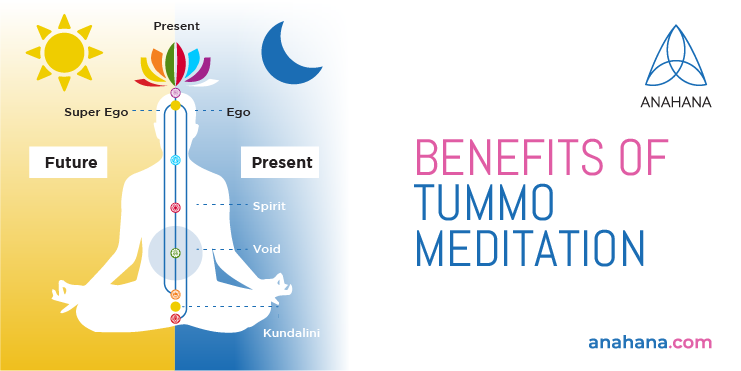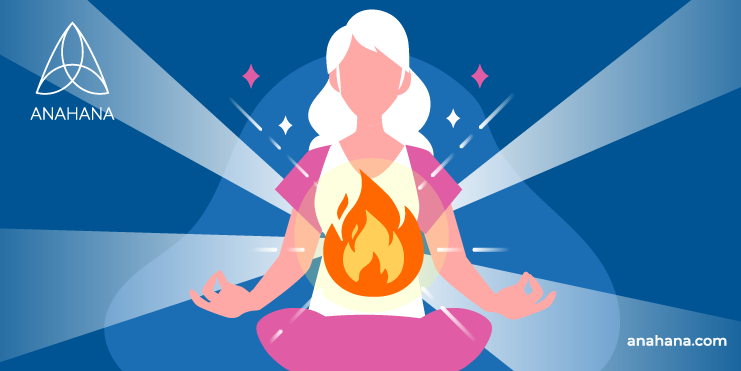
Table of Contents
Step into the realm of Tummo breathing, an enigmatic technique steeped in ancient Tibetan tradition. Known as the 'inner fire' meditation, this practice intertwines a distinctive blend of breathing and visualization methods.
It's not just a ritual; it's a gateway to astounding health benefits, a testament to the profound wisdom of ages past
The Science Behind Tummo Breathing
Tummo breathing, a practice that originated amongst Tibetan Buddhist monks, focuses on the inner heat by harnessing the body's innate ability to generate heat.
This intriguing technique is rooted in ancient tantric meditation and revolves around raising the human body's core temperature through specific breathing exercises.
While it may sound like a mystical concept, the effects and benefits of Tummo breathing are firmly grounded in scientific understanding.
Origins of the Practice
Tummo meditation, a Tibetan Buddhist tradition, is known for its emphasis on inner fire. This ancient practice emerged as an integral part of the Tibetan meditation technique used by monks to reach deep meditative states.
These monks developed the technique as a means of surviving the extreme cold temperatures of the Himalayan mountains.
Over time, it transformed into a spiritual practice believed to lead to enlightenment.
What Is The Inner Fire?
At the heart of Tummo breathing emerged from the concept of the inner fire. In Tibetan tradition, this inner fire is associated with heightened consciousness and vitality.
It is believed that by awakening and controlling this inner fire inside them, practitioners can tap into a source of boundless energy and mental clarity.
During Tummo meditation, inner body heat generates through the visualization of flames at specific points on and within the body.
This visualization creates a sensation of warmth radiating from the spine. The inner fire sustains an elevated core temperature, leading to a prolonged body temperature.
How Does Tummo Breathing Raise Body Temperature?
The key to Tummo breathing's ability to raise core body temperature lies in breath control and visualization.
Tibetan monks practicing Tummo can raise their peripheral body temperatures, such as fingers and toes, by more than 11.7°C. Modest increases of approximately 1.9°C occur in the navel and lumbar regions.
The dynamic interplay of breath and mind triggers physiological responses that lead to an increase in body heat.
The exact causes of the rise in normal body temperature are not fully understood, but the findings indicate two factors affecting temperature increase.
- Forceful breaths: The practice of forceful breaths during Tummo meditation increases the heat radiating from the spine, contributing to the rise in body temperature.
- Inner focus and visualization: Holding the breath and directing inward attention, combined with visualization practices and mental imagery, generate internal heat within the body, leading to an increase in body temperature.
The Benefits Of The Tummo Breathing Technique

Engaging in Tummo breathing exercises can yield many benefits that contribute to overall health and well-being. Some of the notable effects of this practice include:
- Improved Circulation: Tummo breathing enhances blood flow, aiding in the efficient distribution of oxygen and nutrients throughout the body.
- Stress Reduction: The practice activates the parasympathetic nervous system, promoting relaxation and reducing stress.
- Enhanced Immune Function: Elevated body temperature can stimulate the immune system, potentially boosting its defense mechanisms.
- Mind-Body Connection: Tummo breathing fosters a deep connection between the mind and body, enhancing mindfulness and self-awareness.
How Do You Perform Tummo Breathing?
Practicing Tummo breathing requires dedication and consistency, but the process is straightforward. Here's a step-by-step guide to get you started:
- Find a Quiet Space: Choose a calm and quiet environment for your practice, free from distractions.
- Comfortable Seating: Sit in a comfortable cross-legged position with your spine straight and shoulders relaxed.
- Deep Breathing: Inhale deeply through your nose, expanding your abdomen as you fill your lungs.
- Visualization: As you exhale slowly, visualize a radiant, warm light or flames spreading throughout your body.
- Focus and Repetition: Maintain focus on the visualization as you continue the breathing cycle for several minutes.
- Gradual Progression: With time, gradually increase the duration of your practice and the intensity of your visualization.
Tips and Contraindications
While the Tummo breathing method offers numerous benefits, it's important to approach the Tummo practice with caution and respect for your body's limits. Here are some tips and considerations:
Empty Stomach
Practice Tummo breathing on an empty stomach to avoid discomfort since it involves actively using abdominal and pelvic muscles.
Avoid Force
Don't force or strain your breath; let it flow naturally and comfortably. Breathe deeply and engage the pelvic floor muscles at the same time.
Blood Pressure
Consult a healthcare professional before attempting Tummo breathing if you have high blood pressure or cardiovascular issues.
Listen to Your Body
If you experience dizziness, lightheadedness, or discomfort, discontinue the practice and seek guidance.
Fight or Flight Response
Tummo meditation activates the autonomic and sympathetic nervous system, triggering the release of adrenaline and noradrenaline in the sympathetic nervous system. This response prepares the body for action in perceived dangerous situations.
Precautions For Specific Health Conditions
Individuals with hypertension, cardiac disease, respiratory disease, or abnormally elevated blood pressure should not practice Tummo meditation without medical clearance.
It's important to emphasize that Tummo meditation should be approached with caution and undertaken responsibly, particularly for those with specific health conditions.
Consulting with a healthcare professional or an experienced breathwork teacher is crucial to ensure the practice is safe and suitable for individual circumstances.
How Long Does Tummo Breathing Take?
The duration of a Tummo breathing session can vary based on individual preferences, experience, and goals.
Generally, Tummo breathing sessions can range from a few minutes to around 20-30 minutes per session. However, it's important to note that quality and consistency are often more important than the length of the session.
For beginners, starting with shorter sessions of about 5-10 minutes can be a good way to gradually introduce your body to the practice and avoid any potential discomfort.
As you become more accustomed to the technique and develop better control over your breath and visualization, you can gradually extend the duration of your sessions.
Tummo Breathing vs. Wim Hof Method, Kapalbhati, and Bhastrika

Tummo Breathing, Wim Hof Method, Kapalbhati, and Bhastrika are distinct breathing techniques with unique characteristics and purposes.
While they share some similarities, they also have key differences in terms of their origins, practices, effects, and intended outcomes. Here's an overview of each technique and the key differences between them:
Difference in Origins
Wim Hof developed the Wim Hof Method based on his personal experiences and experimentation with extreme cold exposure and breathwork.
Kapalbhati and Bhastrika are both pranayama techniques from the yogic tradition, originating in ancient India.
Focus and Intent
Tummo primarily focuses on generating inner heat, achieving deep meditation, and progressing spiritually.
The Wim Hof Method aims to improve physical and mental well-being, enhance resilience, and promote self-awareness.
Kapalbhati and Bhastrika are focused on cleansing the respiratory system, increasing energy, and preparing the body for meditation.
Breathing Patterns
Tummo involves specific patterns of breathing, various visualization techniques, and energy flow techniques.
The Wim Hof Method combines deep breaths, breath retention, and meditation.
Kapalbhati involves forceful exhalations and passive inhalations.
Bhastrika incorporates rapid and forceful inhalations and exhalations.
Should You Try Tummo Breathing?
With its blend of ancient wisdom and modern scientific understanding, Tummo breathing offers a unique avenue for enhancing your health and well-being.
If you're seeking a practice that combines breathwork, visualization, and mindfulness meditation, Tummo breathing might be worth exploring.
As with any new technique, it's wise to approach it with an open mind, a willingness to learn, and respect for your body's signals.
Frequently Asked Questions
How Is Tummo Breathing Similar To Buteyko Breathing?
While both Tummo and Buteyko breathing techniques involve breath control, they differ in their goals.
Tummo aims to raise core body temperature and enhance vitality, while the Buteyko breathing technique focuses on reducing over-breathing and increasing oxygen delivery to tissues.
How Can Breathing Be Used To Calm The Body And Mind?
Conscious, deep breathing activates the parasympathetic and autonomic nervous system together, promoting relaxation and reducing stress. This has a calming effect on both the body and mind.
How Often Should You Practice Tummo Meditation?
Your Tummo breathing practice frequency depends on your individual goals and comfort level. Starting out g tummo breathing with a few minutes a day and gradually increasing the duration can be a prudent approach.
References
The Influence of Buddhist Meditation Traditions on the Autonomic System and Attention
Episode #8 Comparing Buteyko and Wim Hof – Wilfried Ehrmann › Science on the Rocks
Tummo Meditation | Your Inner Fire and the Wim Hof Method.
Tummo breathing: Benefits of tummo, and how to do it
Disclaimer
The contents of this article are provided for informational purposes only and are not intended to substitute for professional medical advice, diagnosis, or treatment. It is always recommended to consult with a qualified healthcare provider before making any health-related changes or if you have any questions or concerns about your health. Anahana is not liable for any errors, omissions, or consequences that may occur from using the information provided.

By: Clint Johnson
Clint is the driving force and founder of Anahana. Clint teaches Yoga, Pilates, mindful breathing, and meditation, catering to a global community of students and teachers.